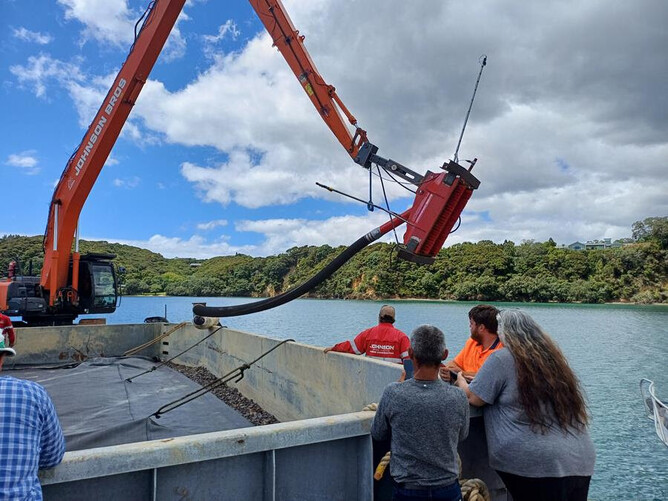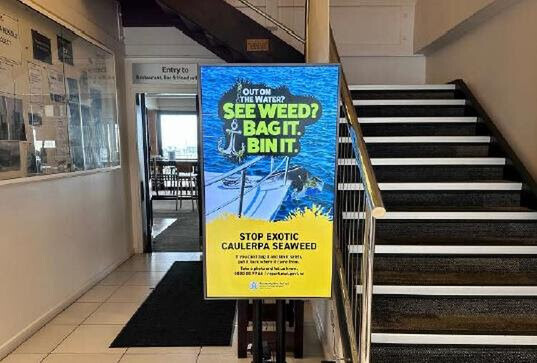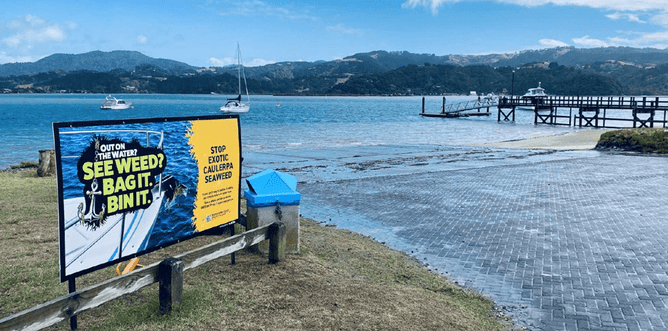In this update we cover the work underway in the Exotic Caulerpa Accelerated Programme - a seven project programme of work using the recent $5 million funding boost to fast-track the development of caulerpa removal methods and learn more about this invasive pest.
Full steam ahead with Omakiwi Cove suction dredging
Northland Regional Council (NRC) has just signed a $3.3 million contract with Biosecurity New Zealand to rapidly develop the suction dredge technology that's currently under trial in Omakiwi Cove in the Bay of Islands.
Work done under the contract (Statement of Work) will enhance the effort to date by NRC, Ngāti Kuta, Patukeha and local marine engineers Johnson Bros.
This flagship project in the accelerated programme features a large, remote-controlled suction head (somewhat like a vacuum cleaner) with rotating brushes mounted on a barge. Exotic caulerpa, including its network of roots, is sucked from the seabed and captured in a sieve-like bag for draining, after which the debris is transferred to shore for disposal.
Currently the team is focused on testing removal rates and developing a new sand separating kit to minimise the amount of seabed that is removed with the caulerpa.
It’s hoped that ultimately the dredge will be able to efficiently remove exotic caulerpa in a range of densities from sparse coverage through to areas of seafloor with up to 75% coverage. If successful, the technology could remove the significant infestation of caulerpa in Omakiwi Cove and potentially be applied to other areas.
Good progress on other projects
Work’s underway to set up diver-assisted suction dredging to remove caulerpa from Iris Shoal near Kawau Island. Ngāti Manuhiri and MPI are working in partnership to deliver this project. The Iris Shoal project is the second stage of the diver assisted suction dredge trial, with the first stage having been completed at Aotea at the end of last year. As with the Aotea trial, NIWA is leading operations and Bay Underwater will be providing suction dredge services.
Another project, being run at Waiheke Island, aims at improving surveillance methods. It is being developed and tested with input from stakeholders. It is proposed that the tool developed will capture geo-referenced, high-quality imagery and video footage rapidly over large areas of ocean floor, and AI algorithms will be used to automate the detection of exotic caulerpa.
The work to resurvey Ahuahu Great Mercury Island and understand the extent of exotic caulerpa infestation around the island is being administered by Waikato Regional Council with active engagement from Ngati Hei.
At Aotea Great Barrier Island, Auckland Council will lead the project to manage the removal of exotic caulerpa by diver-assisted suction dredging around priority areas at Man o’ War Passage (Port Fitzroy), Motuhaku Island (Port Abercrombie) and Katherine Bay. The aim of this project is to try to contain the slow creeping spread of caulerpa from areas of dense infestation.
A sixth project is setting up a National Steering Group to provide future strategic advice and decision-making for the exotic caulerpa response into the future. A list of potential group members is being finalised.
Making the caulerpa message visible to boaties
A part of the accelerated programme has been boosting the existing summer campaign of messaging to boaties and fishers.
Physical billboards, posters and decals for bait fridges have been installed at some 110 sites across the upper North Island at locations that mariners visit.
Additional radio advertising has run over the long Easter weekend through Mediaworks stations.
Since the caulerpa summer advertising campaign started at the end of November, there have been 63,000 views on Biosecurity New Zealand’s caulerpa landing page, where 94% of viewing traffic is driven from campaign advertising.
You can help
Boaties, fishers and divers have a role to play in slowing the spread of exotic caulerpa to new locations.
The current advertising campaign encourages water users to check their anchor, anchor chain and other equipment before moving location. Make sure there’s no seaweed attached, but if there is, remove it, securely bag it and dispose of it in a rubbish bin back at shore.
There are also rules in place at affected locations. These rules effectively ban anchoring and some fishing activities and are there because caulerpa can be spread over long distances as small pieces caught up on fragments attached to anchors, anchor chains and fishing/diving gear.
A rāhui is also in place on some boating and fishing activities in locations where exotic caulerpa has been found.
We need everyone to play their part. If you think you’ve seen exotic caulerpa, report it to Biosecurity New Zealand on 0800 80 99 66 or online at report.mpi.govt.nz
Full Information on caulerpa, the rules and reporting is at: Caulerpa brachypus and Caulerpa parvifolia seaweeds




